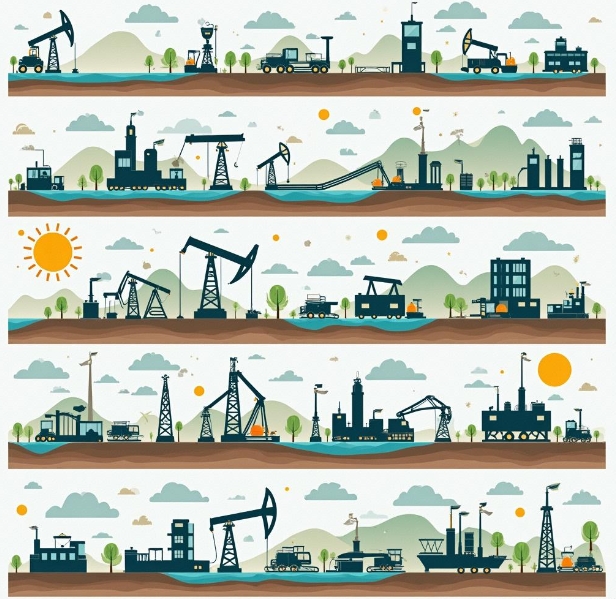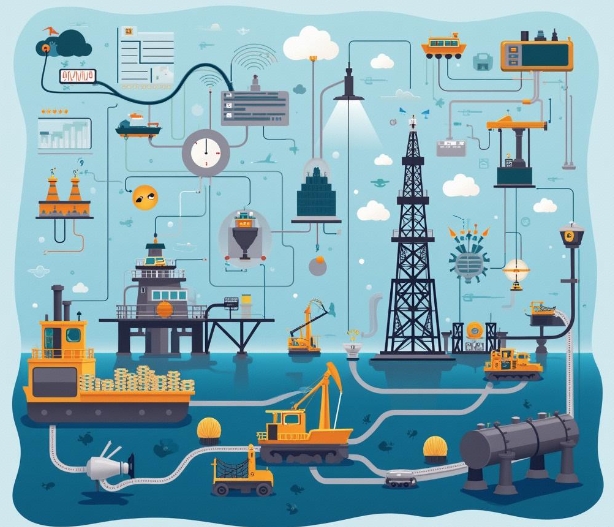Oil and Gas Industry Application Development Solutions
- latest articles
- 1.DApp Development & Customization: Merging Diverse Market Needs with User Experience 2.Analysis of the Core Technical System in DApp Project Development 3.How to achieve cross-chain interoperability in Web3 projects? 4.How does the tokenization of points reconstruct the e-commerce ecosystem? 5.How to Set and Track Data Metrics for a Points Mall? 6.What is DApp Development? Core Concepts and Technical Analysis 7.Inventory of commonly used Web3 development tools and usage tips 8.Development of a Distribution System Integrated with Social E-commerce 9.Six Key Steps for Businesses to Build a Points Mall System 10.What is DApp Development? A Comprehensive Guide from Concept to Implementation
- Popular Articles
- 1.Future Trends and Technology Predictions for APP Development in 2025 2.Analysis of the DeFi Ecosystem: How Developers Can Participate in Decentralized Finance Innovation 3.From Zero to One: How PI Mall Revolutionizes the Traditional E-commerce Model 4.DAPP Development | Best Practices for Professional Customization and Rapid Launch 5.Recommended by the Web3 developer community: the most noteworthy forums and resources 6.From Cloud Computing to Computing Power Leasing: Building a Flexible and Scalable Computing Resource Platform 7.Shared Bike System APP: The Convenient Choice in the Era of Smart Travel 8.How to Develop a Successful Douyin Mini Program: Technical Architecture and Best Practices 9.How to Create a Successful Dating App: From Needs Analysis to User Experience Design 10.From Design to Development: The Complete Process of Bringing an APP Idea to Life
With the continuous growth of global energy demand, the oil and gas industry faces unprecedented challenges. From extraction to transportation, and from storage to refining, every stage requires more efficient, safe, and environmentally friendly solutions. Against this backdrop, the rapid development of technologies such as Information Technology (IT), digital technology, automation, and Artificial Intelligence (AI) has brought unprecedented opportunities for application development in the oil and gas industry. This article will explore solutions for application development in the oil and gas industry, focusing on their applications in improving efficiency, reducing costs, ensuring safety, and optimizing management.
I. Challenges in the Oil and Gas Industry
The oil and gas industry is one of the most critical energy pillars of the global economy. However, with increasing extraction difficulties, stricter environmental regulations, and the global energy transition, the industry faces numerous challenges:
Increasing Difficulty in Resource Extraction: As conventional oil and gas resources gradually deplete, developing more complex fields (such as deep-sea oil and gas, shale gas, and unconventional natural gas) has become a new focus for the industry. Extracting these new resources requires more advanced technologies and equipment, often at high costs.
Heightened Environmental and Safety Requirements: Globally, environmental protection requirements are becoming increasingly stringent. The extraction, transportation, and storage of oil and gas must meet strict environmental and safety standards. Balancing economic benefits with environmental protection has become an urgent issue for the industry.
Significant Cost Control Pressure: With rising exploration and development costs, oil and gas companies face greater pressure to control expenses. Improving operational efficiency and reducing unnecessary expenditures are key to their survival and growth.
High Market Volatility: Fluctuations in oil and gas prices have a profound impact on the industry. Market uncertainties require companies to have stronger adaptability and flexibility.

II. Key Solutions for Application Development
In response to the above challenges, the oil and gas industry urgently needs to optimize operations, enhance production efficiency, ensure safety, and reduce environmental impact through technological means. The following are key application development solutions:
1. Application of Internet of Things (IoT) Technology
IoT technology is widely applied in the oil and gas industry. By installing smart devices on critical components such as equipment, pipelines, and sensors, companies can monitor various data in real-time during production and transportation, promptly identifying issues like equipment failures, pipeline leaks, and production anomalies.
Smart Sensors: Utilize high-precision sensors to collect field data such as pressure, temperature, and flow, transmitting it in real-time via wireless networks to monitoring platforms for remote supervision.
Predictive Maintenance: Based on IoT sensor data, use big data analytics and AI algorithms to predict equipment operating conditions, identify potential failures in advance, and achieve predictive maintenance, reducing downtime and extending equipment lifespan.
Automated Monitoring: Use IoT technology for 24/7 automated monitoring in exploration, production, storage, and transportation processes, ensuring safety and efficiency.
2. Big Data and Artificial Intelligence
The oil and gas industry generates vast amounts of data across exploration, production, transportation, and refining. The integration of big data and AI technologies can significantly enhance the value derived from this data.
Exploration and Development Optimization: Through in-depth analysis of historical data, geological exploration data, and marine data, AI algorithms can help identify potential oil and gas resources and optimize exploration strategies. For example, machine learning models can analyze hydrocarbon reserves in different formations and predict distribution patterns, improving the success rate of resource development.
Production Process Optimization: Big data technology enables real-time collection of production data from oil and gas fields, analyzing processes to identify efficiency bottlenecks and optimize production scheduling. AI technology can build predictive models based on data, precisely adjusting production parameters to reduce costs and increase output.
Intelligent Decision Support: Decision support systems based on big data analytics and AI models provide scientific, real-time recommendations for management in extraction, transportation, and storage. For instance, in volatile market conditions, AI can predict future price trends, helping companies formulate flexible production and sales strategies.
3. Cloud Computing and Edge Computing
Cloud computing and edge computing play increasingly important roles in the oil and gas industry. Cloud computing provides efficient platforms for data storage, processing, and sharing, while edge computing processes data near field devices, achieving lower latency and higher response speeds.
Applications of Cloud Computing: Cloud platforms centralize data management from various devices, facilitating cross-regional and cross-departmental data sharing and collaboration. Additionally, cloud computing enables large-scale data analysis, helping companies make more accurate strategic decisions.
Applications of Edge Computing: In remote operations like oil fields, edge computing processes data locally, avoiding the need to transmit large volumes to the cloud and improving response times. For example, during drilling, real-time monitoring of equipment status and rapid data processing enable quick decision-making for safe and efficient operations.
4. Automation and Robotics
With advancements in automation, the oil and gas industry increasingly employs robots, drones, and other automated devices to enhance production efficiency and safety.
Drone Inspections: Drones can inspect facilities like pipelines and storage tanks, reducing the safety risks of manual checks. Equipped with high-definition cameras and sensors, they collect on-site images and data for analysis.
Automated Drilling: Automated drilling systems enable unmanned operations in multiple stages of drilling, reducing human error and improving efficiency. For instance, these systems can adjust drill bit positions and optimize drilling paths based on real-time monitoring data.
Robotic Cleaning: In extraction and transportation, pipelines may face blockages and corrosion. Using robots for internal cleaning avoids human entry into hazardous areas, ensuring operational safety.
5. Blockchain Technology
Blockchain technology in the oil and gas industry primarily applies to supply chain and contract management. It enables transparent, secure, and efficient supply chain management systems, reducing risks of information asymmetry and fraud.
Supply Chain Traceability: Blockchain allows tracing of information across production, transportation, and storage stages, ensuring transparency and preventing illegal activities and quality issues.
Smart Contracts: Blockchain-based smart contracts automatically execute agreed terms in oil and gas transactions, minimizing human intervention and improving the efficiency and reliability of contract execution.

III. Implementation Path for Application Development
To realize the practical application of these technologies, oil and gas companies need to prepare in the following areas:
Technology Infrastructure Development: Companies must invest in modern digital infrastructure, including data centers, communication networks, sensors, and equipment, to ensure the smooth operation of various technologies.
Talent and Technical Team Building: The digital transformation of the oil and gas industry relies on specialized technical teams. Companies should focus on training or hiring professionals such as data analysts, AI experts, and automation engineers to drive technology R&D and application.
Data Security and Privacy Protection: As informatization increases, data security becomes a critical concern. Companies need to establish robust data security systems to ensure the privacy and integrity of key data.
Cross-Industry Collaboration and Technological Innovation: The digital transformation of the oil and gas industry requires collaboration with sectors like IT and the internet industry. Joint innovation can accelerate the adoption of new technologies and drive industry progress.
Conclusion
The oil and gas industry is in an era of rapid transformation. The widespread application of information technology, automation, big data, and AI not only brings higher operational efficiency and safety but also opens new paths for sustainable development. In the future, with continuous technological advancements and innovation, the digital transformation of the oil and gas industry will deepen, steering the entire sector toward greater intelligence and environmental sustainability.
-

How to Use App Development to Boost Conversion Rates on E-commerce Platforms
With the widespread adoption of smartphones and the rapid development of mobile ···
-

How APP Development Facilitates Digital Transformation and Innovation
With the rapid advancement of information technology, digital transformation has···
-

App Store Optimization and SEO Strategies in App Development
In today's rapidly evolving mobile internet landscape, apps have become essentia···

 Blockchain
Blockchain










